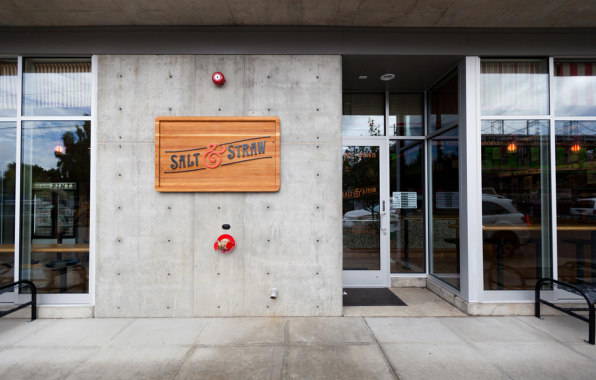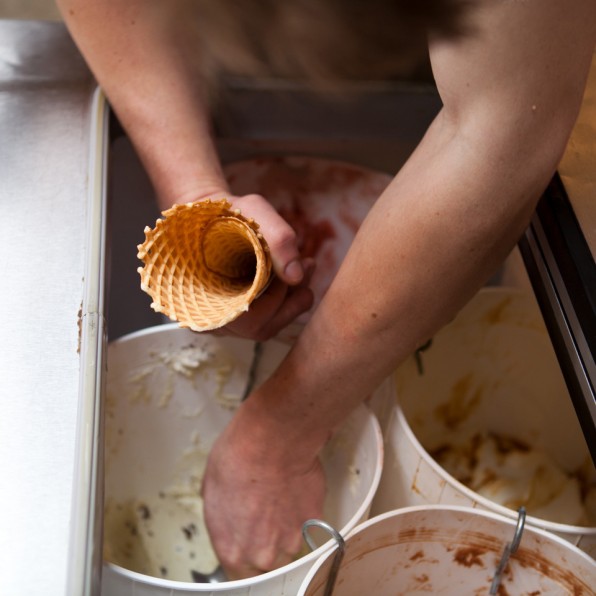This Ice Cream Is Made From Food Waste (It’s Delicious)
The ice cream is a rich, off-white color, streaked through with warm brown apple butter that cuts the sweetness of the spiced-rum-flavored cream. On the menu of Salt & Straw, the Portland-based, small-batch ice cream institution, the unusual flavor combination is not out of place; Kim and Tyler Malek, the cousins behind Salt & Straw, have made a name for themselves selling offbeat takes on classic staples; their chocolate ice cream is laced with marshmallow fluff, and their strawberry holds hints of honey balsamic vinegar and black pepper.

But when Second-Steeped Rum Spices and Apple Butter hits Salt & Straw’s scoop shops in June, it’ll draw attention for more than just its unique taste. Every four weeks, Salt & Straw rotates in a new themed seasonal menu, built around integrating other parts of the food world into ice cream. For instance, one menu focused on fermented flavors and used sourdough, fish sauce, and fermented honey. This coming June, the series will highlight rescued food; all the flavors will be constructed from food that might have otherwise ended up in the trash. The spices that flavor the apple butter flavor will be rescued from Portland’s East Side Distillery, which makes rum by steeping whole spices—Moroccan peppercorns, Sri Lankan cinnamon, Mexican vanilla, California orange peel. Salt & Straw will re-steep the rum-soaked spices in cream, then ribbon in the caramelized apple butter made from bruised apples that were destined to be tossed.

“We were really struck by the idea that we waste 40% of our food in the United States, and that children in our cities are going hungry,” Kim Malek, who founded Salt & Straw in 2011, tells Fast Company. “If we were able to use that food, we could wipe out hunger.” There are people, she adds, who are doing that work: For the June series, Salt & Straw is working closely with organizations like Urban Gleaners and the Portland Fruit Tree Project, which rescue and redistribute potentially wasted food among communities in need. “We thought: What if we use our menu in June to shine a light on those agencies and tell their story, and see if we can get our customers and the community at large to be more aware of and supportive of these organizations and the work that they’re doing,” Kim says. “We want to show that an apple might be kind of ugly, but that doesn’t mean it’s not perfectly tasty and should be thrown away. We could use it.”

Around one third of the food produced in the world for human consumption–about 1.3 billion tons–is lost or wasted each year. An independent, small-batch ice cream chain, says Tyler Malek, is not going to make a huge dent in that total; he estimates that June series will save around 2,000 pounds of food. But volume, he adds, isn’t the whole picture. “What we’re doing is we’re working with a lot of companies and trying to prove that there’s a viable supply chain here,” Tyler says. “For instance, we’ll be paying fair market value for say, strawberries that a farmer was going to throw away because they were too ripe. That’s actually perfect for us–we’re going to freeze them anyway. We’re trying to prove that this food can be used, and tell our customers that it’s possible to make something incredible and fun out of something that was going to be wasted.”
In the summer months, each of Salt & Straw’s shops is staffed by around 30 people, who are trained extensively in how to explain the origins and thought process behind each flavor; detailed descriptions of the seasonal flavors are also printed on in-store menus and on the website. (The Maleks are in the ice-cream business, but they’re also storytellers; Tyler’s process of dreaming up new flavors begins with conversations with the organizations and people he’s working with. It’s a matter of turning a narrative and a message into ice cream, he says, not the other way around.) On warm days, around 100 people file through each shop every hour. “Our hope is that the collective power of our customers getting to learn about rescued food and the organizations working in this space will translate into support and awareness,” Kim says.
Though the rescued food series is limited to the month of June, Tyler and Kim see the partnerships they’ve formed through the process of developing these flavors reverberating throughout their work going forward. Tyler is in talks with the Portland Fruit Tree Project, which works with houses that grow fruit but don’t harvest it, about an ongoing collaboration; the organization is also selling to cider makers. “There’s money to be made in rescuing food; that’s the proof of concept,” Tyler says.
It also tastes delicious.
Fast Company , Read Full Story
(80)














